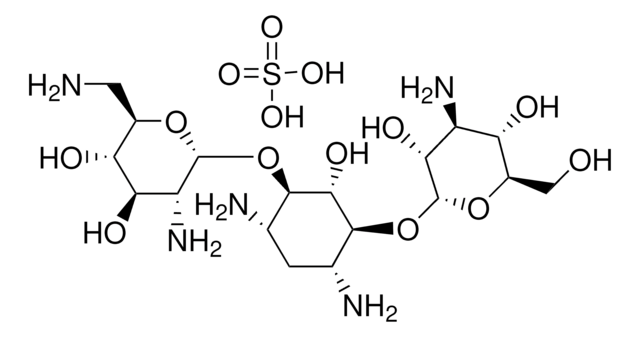B5264
Kanamycin B sulfate salt
aminoglycoside antibiotic
Synonyme(s) :
Bekanamycin sulfate salt
About This Item
Produits recommandés
Niveau de qualité
Forme
powder or crystals
Spectre d'activité de l'antibiotique
Gram-negative bacteria
Gram-positive bacteria
mycoplasma
Mode d’action
protein synthesis | interferes
Température de stockage
−20°C
Chaîne SMILES
OS(O)(=O)=O.NC[C@H]1O[C@H](O[C@@H]2[C@@H](N)C[C@@H](N)[C@H](O[C@H]3O[C@H](CO)[C@@H](O)[C@H](N)[C@H]3O)[C@H]2O)[C@H](N)[C@@H](O)[C@@H]1O
InChI
1S/C18H37N5O10.H2O4S/c19-2-6-11(26)12(27)9(23)17(30-6)32-15-4(20)1-5(21)16(14(15)29)33-18-13(28)8(22)10(25)7(3-24)31-18;1-5(2,3)4/h4-18,24-29H,1-3,19-23H2;(H2,1,2,3,4)/t4-,5+,6+,7+,8-,9+,10+,11+,12+,13+,14-,15+,16-,17+,18+;/m0./s1
Clé InChI
YGTPKDKJVZOVCO-KELBJJLKSA-N
Vous recherchez des produits similaires ? Visite Guide de comparaison des produits
Catégories apparentées
Description générale
Application
Actions biochimiques/physiologiques
Mode of Resistance: Aminoglycoside-modifying enzymes (including acetyltransferase, phosphotransferase, nucleotidyltransferase) can alter this antibiotic, preventing its interaction with ribosomes.
Antimicrobial Spectrum: Kanamycin sulfate is effective against gram-negative and gram-postiive bacteria, and mycoplasma.
Notes préparatoires
Autres remarques
Code de la classe de stockage
11 - Combustible Solids
Classe de danger pour l'eau (WGK)
WGK 2
Point d'éclair (°F)
Not applicable
Point d'éclair (°C)
Not applicable
Équipement de protection individuelle
Eyeshields, Gloves, type N95 (US)
Certificats d'analyse (COA)
Recherchez un Certificats d'analyse (COA) en saisissant le numéro de lot du produit. Les numéros de lot figurent sur l'étiquette du produit après les mots "Lot" ou "Batch".
Déjà en possession de ce produit ?
Retrouvez la documentation relative aux produits que vous avez récemment achetés dans la Bibliothèque de documents.
Les clients ont également consulté
Notre équipe de scientifiques dispose d'une expérience dans tous les secteurs de la recherche, notamment en sciences de la vie, science des matériaux, synthèse chimique, chromatographie, analyse et dans de nombreux autres domaines..
Contacter notre Service technique






